Diving Deep with the Flex Component Life Cycle
- 1. Diving Deep with the Flex Component Lifecycle Joshua Jamison EffectiveUI www.effectiveui.com January 30, 2009
- 2. Who am I? ‣ Joshua Jamison • Software Architect @ EffectiveUI
- 3. Who are you (hopefully)? ‣ Beginner to intermediate level developers ‣ Anyone who doesn’t currently understand the lifecycle ‣ Anyone who wants a good review of the basics
- 4. What’s this about, anyway? ‣ Flex component lifecycle ‣ Flex frame cycle (“elastic racetrack”)
- 5. Flex Component Lifecycle ‣ What is it? • The way the framework interacts with every Flex component • A set of methods the framework calls to instantiate, control, and destroy components • Methods that make the most of the elastic racetrack
- 6. Elastic Racetrack: introduction image courtesy of Ted Patrick ‣ Flex component lifecycle is built on this frame model ‣ More on this later
- 7. A frame in AS3 image courtesy of Sean Christmann
- 8. Phases of the Lifecycle ‣ 3 Main Phases: ‣ BIRTH: • construction, con guration, attachment, initialization ‣ LIFE: • invalidation, validation, interaction ‣ DEATH: • detachment, garbage collection
- 9. Birth Congratulations: You’re about to have a component.
- 10. Construction Birth construction con guration attachment initialization Life Death
- 11. What is a constructor? ‣ A function called to instantiate (create in memory) a new instance of a class Birth construction con guration attachment initialization Life Death
- 12. How is a constructor invoked? Actionscript: var theLabel : Label = new Label(); MXML: <mx:Label id="theLabel"/> Birth construction con guration attachment initialization Life Death
- 13. What does a constructor have access to? ‣ Properties on the class ‣ Methods on the class ‣ Children have not yet been created! Birth construction con guration attachment initialization Life Death
- 14. What does an ActionScript3 constructor look like? public function ComponentName() { super(); //blah blah blah } ‣ No required arguments (if it will be used in MXML); zero, or all optional ‣ Only one per class (no overloading!) ‣ No return type Birth ‣ Must be public construction con guration ‣ Calls super() to invoke superclass constructor; if attachment initialization you don’t, the compiler will! Life Death
- 15. What does an MXML constructor look like? ‣ No need to de ne one. In fact, if you try to put one in an <mx:Script> block, you’ll get an error. ‣ Why? Remember: MXML = Actionscript. A constructor is created by the compiler in the Actionscript generated from the MXML. Birth ‣ Specify “-keep” in the Flex Builder construction con guration compiler arguments and look at the attachment generated code to verify this. initialization Life Death
- 16. What should a constructor do? ‣ Not much. Since the component’s children have not yet been created, there’s not much that can be done. ‣ There are speci c methods (such as createChildren) that should be used for most of the things you’d be tempted to put in a constructor. Birth ‣ A good place to add event listeners to the construction con guration object. attachment initialization Life Death
- 17. Don’t create or attach children in the constructor ‣ It’s best to delay the cost of createChildren calls for added children until it’s necessary Birth construction con guration attachment initialization Life Death
- 18. Con guration Birth construction con guration attachment initialization Life Death
- 19. Con guration ‣ The process of assigning values to properties on objects ‣ In MXML, properties are assigned in this phase, before components are attached or initialized <local:SampleChild property1="value!"/> Birth construction con guration attachment initialization Life Death
- 20. Hooray: Sample code! <mx:Application ...> ... <local:SampleChild property1="value!"/> </mx:Application> Output: SampleChild constructor Birth SampleChild.property1 setter construction Adding child SampleChild4 con guration attachment initialization Life Death
- 21. Con guration and Containers ‣ Containers must not expect their children have to be instantiated when properties are set. <mx:Application ...> <local:SampleContainer property1="value!"> <local:SampleChild property1="value!"/> </local:SampleContainer> </mx:Application> SampleContainer constructor Birth construction SampleContainer.property1 setter con guration SampleChild constructor attachment SampleChild.property1 setter initialization Life Death
- 22. Con guration Optimization ‣ To avoid performance bottlenecks, make your setters fast and defer any real work until validation ‣ We’ll talk more about deferment in the validation / invalidation section Birth construction con guration attachment initialization Life Death
- 23. Attachment Birth construction con guration attachment initialization Life Death
- 24. What is attachment? ‣ Adding a component to the display list (addChild, addChildAt, MXML declaration) ‣ The component lifecycle is stalled after con guration until attachment occurs. Birth construction con guration attachment initialization Life Death
- 25. Consider this component: public class A extends UIComponent { public function A() { (It traces all of its methods.) trace( "CONSTRUCTOR" ); super(); } override protected function createChildren() : void { trace( "CREATECHILDREN" ); super.createChildren(); } override protected function measure() : void { trace( "MEASURE" ); super.measure(); } override protected function updateDisplayList(width:Number, height:Number) : void { trace( "UPDATEDISPLAYLIST" ); super.updateDisplayList(width,height); } override protected function commitProperties():void { trace( "COMMITPROPERTIES" ); super.commitProperties(); }
- 26. And this application: <mx:Application ...> <mx:Script> <![CDATA[ override protected function createChildren() : void { super.createChildren(); var a : A = new A(); } ]]> </mx:Script> </mx:Application> Output: CONSTRUCTOR ‣ Without attachment, the rest of the lifecycle doesn’t happen.
- 27. But what about this application? <mx:Application ...> <mx:Script> <![CDATA[ override protected function createChildren() : void { super.createChildren(); var a : A = new A(); this.addChild( a ); } ]]> </mx:Script> </mx:Application> Output: CONSTRUCTOR CREATECHILDREN COMMITPROPERTIES MEASURE UPDATEDISPLAYLIST ‣ Moral of the story: don’t add components to the stage until you need them.
- 28. Initialization Birth construction con guration attachment initialization Life Death
- 29. Initialization ‣ 2 phases, 3 events: 1. ‘preInitialize’ dispatched Create 2. createChildren(); called 3. ‘initialize’ dispatched Validate 4. rst validation pass occurs 5. ‘creationComplete’ dispatched Birth construction con guration attachment initialization Life Death
- 30. createChildren() ‣ MXML uses the createChildren() method to add children to containers ‣ Override this method to add children using AS • Follow MXML’s creation strategy: create, con gure, attach override protected function createChildren():void { ... create textField = new UITextField(); textField.enabled = enabled; con gure textField.ignorePadding = true; textField.addEventListener("textFieldStyleChange", textField_textFieldStyleChangeHandler); ... ... attach } addChild(DisplayObject(textField));
- 31. rst validation pass ‣ Invalidation is not part of initialization - only Validation ‣ Validation consists of 3 methods: • commitProperties() • measure() • updateDisplayList() ‣ more on these later Birth construction con guration attachment initialization Life Death
- 32. Life They grow up so fast.
- 33. Invalidation Birth Life invalidation validation interaction Death
- 34. Invalidation / Validation cycle ‣ Flex imposes deferred validation on the Flash API • goal: defer screen updates until all properties have been set ‣ 3 main method pairs to be aware of: • invalidateProperties() -> commitProperties() • invalidateSize() -> measure() • invalidateDisplayList() -> updateDisplayList()
- 35. Invalidation / Validation theory ‣ First, a little theory.
- 36. Deferment ‣ Deferment is the central concept to understand in the component Life-cycle ‣ Use private variables and boolean ags to defer setting any render-related properties until the proper validation method
- 37. Text-book example Bad: public function set text(value:String):void { myLabel.text = value; // Possible Error! during first config phase, // myLabel might not exist! } Good: private var _text:String = ""; public function set text(value:String):void override protected function { commitProperties():void{ textSet = true; { _text = value; if(textChanged){ textChanged = true; myLabel.text = _text; textChanged = false; invalidateProperties(); } invalidateSize(); super.commitProperties(); invalidateDisplayList(); } }
- 38. The Elastic Racetrack revisited image courtesy of Sean Christmann Invalidation occurs here
- 39. Invalidation methods ‣ invalidateProperties() • Any property changes ‣ invalidateSize() • Changes to width or height ‣ invalidateDisplayList() • Changes to child component size or position Birth Life invalidation validation interaction Death
- 40. Invalidation example 1 <mx:Application> <mx:Script> <![CDATA[ import mx.collections.ArrayCollection; [Bindable] public var arr : ArrayCollection = new ArrayCollection(); public function onClick() : void { var c : int = 0; while( c++ < 20 ) { arr.addItem( c ); } } ]]> </mx:Script> <mx:VBox> <mx:Button label="Click me!" click="onClick()"/> <test:BadList id="theList" dataProvider="{arr}"/> </mx:VBox> </mx:Application>
- 41. Invalidation example 2 public class BadList extends VBox { private var _dataProvider : ArrayCollection; public function set dataProvider( arr : ArrayCollection ) : void { this._dataProvider = arr; arr.addEventListener( CollectionEvent.COLLECTION_CHANGE, dataProviderChangeHandler ); } private function dataProviderChangeHandler( e : Event ) : void { this.removeAllChildren(); for each( var n : Number in this._dataProvider ) { var l : Label = new Label(); l.text = n.toString(); this.addChild( l ); } } public function BadList() {} } Result: dataProviderChangeHandler called 20 times
- 42. Invalidation example 3 public class GoodList extends VBox { private var _dataProvider : ArrayCollection; private var _dataProviderChanged : Boolean = false; public function set dataProvider( arr : ArrayCollection ) : void { this._dataProvider = arr; arr.addEventListener( CollectionEvent.COLLECTION_CHANGE, dataProviderChangeHandler ); this._dataProviderChanged = true; this.invalidateProperties(); } override protected function commitProperties():void { super.commitProperties(); if( this._dataProviderChanged ) { this.removeAllChildren(); for each( var n : Number in this._dataProvider ) { var l : Label = new Label(); l.text = n.toString(); Result: commitProperties this.addChild( l ); called only twice (once } this._dataProviderChanged = false; during initialization) } } private function dataProviderChangeHandler( e : Event ) : void { this._dataProviderChanged = true; this.invalidateProperties(); } public function GoodList() {} }
- 43. Validation Birth Life invalidation validation interaction Death
- 44. The Elastic Racetrack revisited Validation occurs here
- 45. Validation ‣ Apply the changes deferred during invalidation ‣ Update all visual aspects of the application in preparation for the render phase ‣ 3 methods: • commitProperties() • measure() Birth Life • updateDisplayList() invalidation validation interaction Death
- 46. commitProperties() ‣ Ely says: “Calculate and commit the effects of changes to properties and underlying data.” ‣ Invoked rst - immediately before measurement and layout Birth Life invalidation validation interaction Death
- 47. commitProperties() cont. ‣ ALL changes based on property and data events go here ‣ Even creating and destroying children, so long as they’re based on changes to properties or underlying data ‣ Example: any list based component with empty renderers on the screen Birth Life invalidation validation interaction Death
- 48. measure() ‣ Component calculates its preferred (“default”) and minimum proportions based on content, layout rules, constraints. ‣ Measure is called bottom up - lowest children rst ‣ Caused by “invalidateSize()” ‣ NEVER called for explicitly sized Birth Life components invalidation validation interaction Death
- 49. overriding measure() ‣ Used for dynamic layout containers (VBox, etc.) ‣ Use getExplicitOrMeasuredWidth() (or height) to get child proportions ‣ ALWAYS called during initialization ‣ Call super.measure() rst! ‣ Set measuredHeight, measuredWidth for Birth the default values; measuredMinHeight Life invalidation and measuredMinWidth for the minimum. validation interaction Death
- 50. measure() cont. ‣ Not reliable - Framework optimizes away any calls to measure it deems “unecessary” Birth Life invalidation validation interaction Death
- 51. updateDisplayList() ‣ All drawing and layout code goes here, making this the core method for all container objects ‣ Caused by invalidateDisplayList(); ‣ Concerned with repositioning and resizing children ‣ updateDisplayList() is called top-down Birth Life invalidation validation interaction Death
- 52. Overriding updateDisplayList() ‣ Usually call super.updateDisplayList() rst • super() is optional - don’t call it if you’re overriding everything it does ‣ Size and lay out children using move(x,y) and setActualSize(w,h) if possible • I never have good luck with setActualSize() Birth Life invalidation validation interaction Death
- 53. Elastic Racetrack cont. ‣ User Actions • Dispatch invalidation events • Interact with any non-validation events from this frame (mouse movements, timers, etc.)
- 54. Elastic Racetrack Cont. ‣ Invalidate Action • Process all validation calls ‣ Render Action • Do the heavy lifting - actually draw on the screen
- 55. The Elastic Racetrack revisited Queued Invalidation Deferred Validation Render!
- 56. Interaction Birth Life invalidation validation interaction Death
- 57. How do objects know when something happens? ‣ Events: objects passed around when anything interesting goes on (clicks, moves, changes, timers...) ‣ If something happens to a component, it “ res” or “dispatches” the event ‣ If another component wants to know when something happens, it “listens” for events Birth Life ‣ Event-based architecture is loosely- invalidation validation coupled interaction Death
- 58. Bene ts of Loosely-Coupled Architectures ‣ Everything becomes more reusable ‣ Components don’t have to know anything about the components in which they’re used Birth Life invalidation validation interaction Death
- 59. Who can dispatch events? ‣ Subclasses of EventDispatcher • EventDispatcher inherits directly from Object ‣ Simply call dispatchEvent(event) to re off an event when something happens Birth Life invalidation validation interaction Death
- 60. How to tell events apart? ‣ Event class • Different classes allow for customized payloads ‣ “type” eld: a constant Birth Life invalidation validation interaction Death
- 61. Common Events ‣ Event.CHANGE ‣ MouseEvent.CLICK ‣ FlexEvent.CREATION_COMPLETE ‣ Event.RESIZE ‣ MouseEvent.ROLL_OUT Birth Life invalidation validation interaction Death
- 62. Handling Events ‣ <mx:Button id=”theButton” click=”callThisFunction(event)”/> ‣ theButton.addEventListener( MouseEvent .CLICK, callThisFunction ) Birth Life invalidation validation interaction Death
- 63. Event Propagation ‣ Three phases: Capturing, Targeting, Bubbling Application Application Capturing Bubbling Phase Phase Target Targeting Birth Phase Life invalidation validation interaction Death
- 64. Event Propagation ‣ Three phases: Capturing, Targeting, Bubbling <mx:Application initialize="onInitialize()"> <mx:Script> <![CDATA[ public function onInitialize() : void { this.addEventListener( MouseEvent.CLICK, clickHandler, true ); this.addEventListener( MouseEvent.CLICK, clickHandler, false ); outer.addEventListener( MouseEvent.CLICK, clickHandler, true ); outer.addEventListener( MouseEvent.CLICK, clickHandler, false ); inner.addEventListener( MouseEvent.CLICK, clickHandler, true ); inner.addEventListener( MouseEvent.CLICK, clickHandler, false ); button.addEventListener( MouseEvent.CLICK, clickHandler, true ); button.addEventListener( MouseEvent.CLICK, clickHandler, false ); } public function clickHandler( e : Event ) : void { trace("----------------------------------------------------------"); trace("TARGET: " + e.target.id ); trace("CURRENT TARGET: " + e.currentTarget.id ); trace("PHASE: " + ( e.eventPhase == 1 ? "CAPTURE" : ( e.eventPhase == 2 ? "TARGET" : "BUBBLE" ) ) ); } ]]> </mx:Script> <mx:VBox> <mx:Panel id="outer"> <mx:TitleWindow id="inner"> <mx:Button id="button"/> </mx:TitleWindow> Birth </mx:Panel> </mx:VBox> Life </mx:Application> invalidation ‣ validation interaction Death
- 65. Event Propagation ---------------------------------------------------------- TARGET: button CURRENT TARGET: eventTest PHASE: CAPTURE ---------------------------------------------------------- TARGET: button CURRENT TARGET: outer PHASE: CAPTURE ---------------------------------------------------------- TARGET: button CURRENT TARGET: inner PHASE: CAPTURE ---------------------------------------------------------- TARGET: button CURRENT TARGET: button PHASE: TARGET ---------------------------------------------------------- TARGET: button CURRENT TARGET: inner PHASE: BUBBLE ---------------------------------------------------------- TARGET: button CURRENT TARGET: outer PHASE: BUBBLE ---------------------------------------------------------- Birth TARGET: button CURRENT TARGET: eventTest Life PHASE: BUBBLE invalidation validation interaction Death
- 66. Stopping events from propagating ‣ stopPropagation() : Prevents processing of any event listeners in nodes subsequent to the current node in the event ow ‣ stopImmediatePropagation() : Prevents processing of any event listeners in the current node and any subsequent nodes in the event ow Birth Life invalidation validation interaction Death
- 67. target vs. currentTarget ‣ target: the object that dispatched the event (doesn’t change) ‣ currentTarget: the object who is currently being checked for speci c event listeners (changes) Birth Life invalidation validation interaction Death
- 68. Dispatching events from custom components ‣ MXML: <mx:Metadata> [Event(name="atePizza", type="flash.events.JoshEvent")] </mx:Metadata> ‣ Actionscript: [Event(name="atePizza", type="flash.events.JoshEvent")] public class MyComponent extends UIComponent { ... } Birth Life invalidation validation interaction Death
- 69. Death All good things come to an end.
- 70. Detachment Birth Life Death detachment garbage collection
- 71. Detachment ‣ “Detachment” refers to the process of removing a child from the display list ‣ These children can be re-parented (brought back to life) or abandoned to die ‣ Abandoned components don’t get validation calls and aren’t drawn ‣ If an abandoned component has no more Birth active references, it *should* be garbage- Life Death collected detachment garbage collection
- 72. Detachment cont. ‣ Re-parenting isn’t cheap, but it’s cheaper than re-creating the same component twice ‣ Children do not need to be removed from their parent before being re-parented, but always should be ‣ Consider hiding rather than removing • set visible and includeInLayout to false Birth Life Death detachment garbage collection
- 73. Garbage Collection Birth Life Death detachment garbage collection
- 74. Garbage Collection ‣ The process by which memory is returned to the system ‣ Only objects with no remaining references to them will be gc’d • Set references to detached children to “null” to mark them for GC ‣ Talk to Grant Skinner about forcing GC Birth • http://gskinner.com/blog/archives/2006/08/as3_resource_ma_2.html Life Death detachment garbage collection
- 75. Conclusion ‣ Defer, Defer, DEFER! ‣ Use validation methods correctly ‣ Remember the elastic racetrack
- 76. References ‣ Ely Green eld: “Building a Flex Component” • http://www.on ex.org/ACDS/ BuildingAFlexComponent.pdf ‣ Cha c Kazoun, Joey Lott: “Programming Flex 2” by O’Reilly • http://oreilly.com/catalog/9780596526894/ ‣ Colin Moock: “Essential Actionscript 3.0” by O’Reilly • http://oreilly.com/catalog/9780596526948/ index.html




















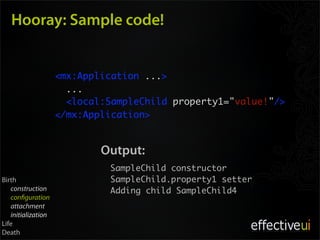





![And this application:
<mx:Application ...>
<mx:Script>
<![CDATA[
override protected function createChildren() : void {
super.createChildren();
var a : A = new A();
}
]]>
</mx:Script>
</mx:Application>
Output: CONSTRUCTOR
‣ Without attachment, the rest of the lifecycle
doesn’t happen.](https://image.slidesharecdn.com/divingdeepwiththeflexcomponentlifecycle-100913115235-phpapp02/85/Diving-Deep-with-the-Flex-Component-Life-Cycle-26-320.jpg)
![But what about this application?
<mx:Application ...>
<mx:Script>
<![CDATA[
override protected function createChildren() : void {
super.createChildren();
var a : A = new A();
this.addChild( a );
}
]]>
</mx:Script>
</mx:Application> Output: CONSTRUCTOR
CREATECHILDREN
COMMITPROPERTIES
MEASURE
UPDATEDISPLAYLIST
‣ Moral of the story: don’t add components to the
stage until you need them.](https://image.slidesharecdn.com/divingdeepwiththeflexcomponentlifecycle-100913115235-phpapp02/85/Diving-Deep-with-the-Flex-Component-Life-Cycle-27-320.jpg)



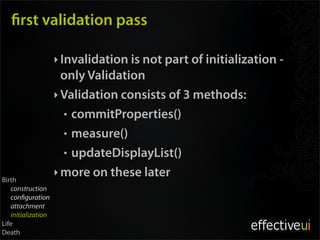
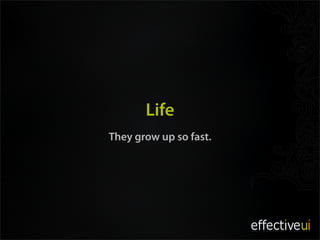







![Invalidation example 1
<mx:Application>
<mx:Script>
<![CDATA[
import mx.collections.ArrayCollection;
[Bindable]
public var arr : ArrayCollection = new ArrayCollection();
public function onClick() : void {
var c : int = 0;
while( c++ < 20 ) {
arr.addItem( c );
}
}
]]>
</mx:Script>
<mx:VBox>
<mx:Button label="Click me!" click="onClick()"/>
<test:BadList id="theList" dataProvider="{arr}"/>
</mx:VBox>
</mx:Application>](https://image.slidesharecdn.com/divingdeepwiththeflexcomponentlifecycle-100913115235-phpapp02/85/Diving-Deep-with-the-Flex-Component-Life-Cycle-40-320.jpg)
















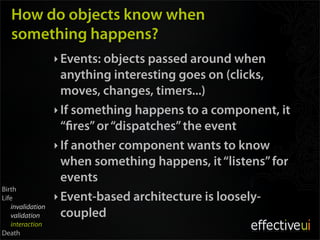




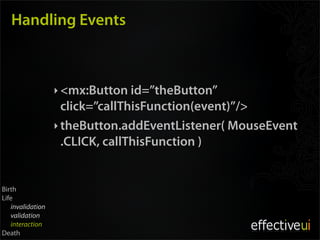

![Event Propagation
‣ Three phases: Capturing, Targeting, Bubbling
<mx:Application initialize="onInitialize()">
<mx:Script>
<![CDATA[
public function onInitialize() : void {
this.addEventListener( MouseEvent.CLICK, clickHandler, true );
this.addEventListener( MouseEvent.CLICK, clickHandler, false );
outer.addEventListener( MouseEvent.CLICK, clickHandler, true );
outer.addEventListener( MouseEvent.CLICK, clickHandler, false );
inner.addEventListener( MouseEvent.CLICK, clickHandler, true );
inner.addEventListener( MouseEvent.CLICK, clickHandler, false );
button.addEventListener( MouseEvent.CLICK, clickHandler, true );
button.addEventListener( MouseEvent.CLICK, clickHandler, false );
}
public function clickHandler( e : Event ) : void {
trace("----------------------------------------------------------");
trace("TARGET: " + e.target.id );
trace("CURRENT TARGET: " + e.currentTarget.id );
trace("PHASE: " + ( e.eventPhase == 1 ? "CAPTURE" : ( e.eventPhase == 2 ? "TARGET" : "BUBBLE" ) ) );
}
]]>
</mx:Script>
<mx:VBox>
<mx:Panel id="outer">
<mx:TitleWindow id="inner">
<mx:Button id="button"/>
</mx:TitleWindow>
Birth </mx:Panel>
</mx:VBox>
Life </mx:Application>
invalidation
‣
validation
interaction
Death](https://image.slidesharecdn.com/divingdeepwiththeflexcomponentlifecycle-100913115235-phpapp02/85/Diving-Deep-with-the-Flex-Component-Life-Cycle-64-320.jpg)


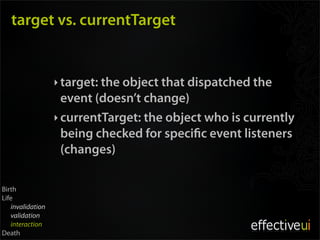
![Dispatching events from custom
components
‣ MXML:
<mx:Metadata>
[Event(name="atePizza", type="flash.events.JoshEvent")]
</mx:Metadata>
‣ Actionscript:
[Event(name="atePizza", type="flash.events.JoshEvent")]
public class MyComponent extends UIComponent
{
...
}
Birth
Life
invalidation
validation
interaction
Death](https://image.slidesharecdn.com/divingdeepwiththeflexcomponentlifecycle-100913115235-phpapp02/85/Diving-Deep-with-the-Flex-Component-Life-Cycle-68-320.jpg)







